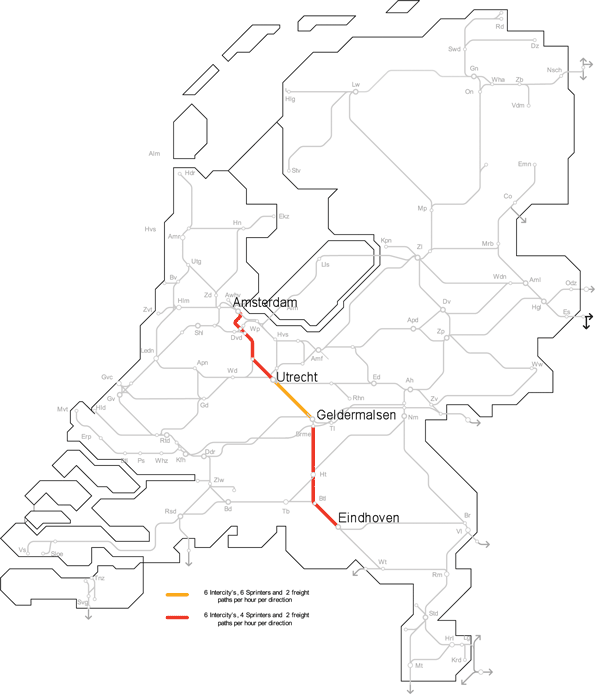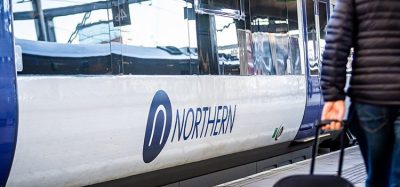Triple A approach tested in practice gives valuable results
Posted: 28 January 2010 | | No comments yet
In Issue 1 2009 of Global Railway Review, an article was published about how ProRail expects to realise a growth of 50% by applying a new approach. This approach is known as the Triple A. In this article, I will discuss the progress since January 2009, but I will first give a brief outline of the scope of Triple A.
In Issue 1 2009 of Global Railway Review, an article was published about how ProRail expects to realise a growth of 50% by applying a new approach. This approach is known as the Triple A. In this article, I will discuss the progress since January 2009, but I will first give a brief outline of the scope of Triple A.
In Issue 1 2009 of Global Railway Review, an article was published about how ProRail expects to realise a growth of 50% by applying a new approach. This approach is known as the Triple A. In this article, I will discuss the progress since January 2009, but I will first give a brief outline of the scope of Triple A.
A different approach of capacity planning and implementation
The limitations of capacity growth in the present way of working largely result from the planning regulations: a capacity bottleneck occurs when the required specifications cannot be complied with on the basis of common standards and principles. Because of this way of working, the Dutch railway network has many bottlenecks on paper. In the new approach, we identify bottlenecks by looking at where substantial and structural hindrances in implementations occur for several trains. In order to avoid this hindrance, the following measures, resulting from practical experience and analyses, are applied:
- Specifically make use of riding time margins and time buffers between the trains
- Solve conflicts between trains only when they actually exist in practice
- Optimise control and adjustment (more control, less adjustment)
- Reduce crossing movements
- Untwine junctions
- Reduce unused capacity claims
- Make use of a public and an internal timetable
A different approach to capacity allocation
In different handling of the capacity allocation, the so-called negotiating table for all parties involved takes a central place. Here the pros and cons are weighed in a well-balanced way based on commercial and social interests, with ProRail as mediating chairman. Participants in the discussion are the passenger operators (and/or underlying concession-granting authorities), freight operators (and/or underlying shippers), the shipping trade (for discussing openings of bridges) and ProRail itself (for maintenance capacity). The four elements are crucial in capacity distribution:
- Specify the capacity requirements
- Explore and make use of the space for solving problems, including:
- Differentiate in time and place
- Streamline trains in bottlenecks
- Streamline frequencies
- Differentiate the impact on the environment
- Make use of the price mechanism
- Find the proper rules of the game
A different way to increase capacity
Capacity increase requires a process that is more than it is now focused on finding the most cost-effective measures. Here it is important that investments are really made the most of. This is possible by concluding long-term agreements between ProRail and the railway operators/authorities: the framework agreements. As the government has always largely or fully financed investments in infrastructure, parties in the railway sector are inclined to search for solutions in ‘hard’ infrastructural measures and have the government finance these. The solution is also often sought in technical system adjustments, such as making the sections between the larger stations entirely four-tracked and changing to an overhead wire voltage of 25 kV. These solutions are expensive and take a lot of time. ProRail wants to take another course with the partners in the railway sector in fulfilling the ambition of a high-frequency train system on the Amsterdam to Eindhoven section in the next few years. Experience in the Netherlands and abroad has shown that solutions for capacity bottlenecks can often be carried out on a smaller scale and more specifically, which allows for considerably shorter implementation periods and reduction of the impact on cities and landscapes. This means specific investments in, for example:
- Traffic measures, for instance for effective and safe handling of conflicting train movements
- Move and add signals
- More silent rolling stock combined with measures concerning the track
- Bottlenecks, for example to reduce conflicting movements as much as possible
- Quick passages of a slow train by a fast train
- Consider another type that does not affect the safety and that minimises the time crossings are closed because of passing trains
- Increase the capacity on yards, both physically and environmentally
- Traction current
Recent developments
The Ministry of Transport and Public Works earmarked €4.5 billion at the end of 2008 for fulfilling the ambition of high-frequency riding on the busiest passenger sections. Apart from this, a future-proof routing for freight along the network must be facilitated. There must be sufficient capacity and quality (phased traffic lights) on the most important routes for freight transport. This ambition must be fulfilled by 2020.
In 2009, ProRail, together with the transporters, has tried to make a proposal on how to spend the €4.5 billion in the best possible way. Various infrastructure packages have been developed that leave room to politics to choose. With these packages, the Ministry has entered into consultation with regional authorities that often also have their own regional transport ambitions. The government will eventually decide how the earmarked money is best spent before the summer of 2010.
The Triple A approach has been substantially applied in each of the worked-out infrastructure packages. It is estimated that without this approach the required investment level would probably be twice as high.
The confidence of the transporters in the Triple A approach grew in 2009. However, some aspects of the approach require some further argumentation.
The possibility occurred in the first week of September 2009 to gain some practical experience in a few components of this approach. A large-scale test was performed to see under which conditions high-frequency railway transport is possible on the section from Amsterdam to Eindhoven. This is quite revolutionary for the railway sector in the Netherlands (experimenting with possible consequences for passengers and shippers was no option until now), but entirely in line with the Triple A approach: see how things can be done differently and here lay the priority with the operational employees of the transporters and ProRail. Therefore, this test was an excellent opportunity to test Triple A in practice.
An experiment was carried out on the section from Amsterdam to Eindhoven with a first form of a high-frequency train system. Six intercity trains per hour in each direction at 10 minute intervals rode between Amsterdam and Eindhoven during the morning and evening rush hours. Additionally, six slow trains per hour in each direction at 10 minute intervals rode in the middle part of the section between Utrecht and Geldermalsen. Also, two freight paths per hour in each direction were available for freight operators in that part of the section. Usually four intercity trains and four slow trains plus a maximum of two freight paths per hour in each direction ride on this two-track section.
This is impossible with the conventional method of planning, distributing and implementing on paper. Therefore, the planning standards were deviated during the test week with respect to some bottlenecks. Also, freight paths with higher speeds were planned in order to avoid bottlenecks based on the knowledge that this higher speed can often be achieved in practice.
Thus, the developed timetable was simulated and discussed in various meetings with the people who have to implement this schedule. After this, feedback from these professionals and the results of the simulations were processed again in the timetable. However, the risk of dispunctuality still seemed to be high beforehand.
The control and adjustment organisations of ProRail and transporters developed various handling scenarios about how to cope with disturbances in the train schedule in advance. This was done very specifically for each location. On which locations can the train schedule be adjusted effectively and where is interference in the train schedule more unfavourable than it is favourable? The most important principle applied by these organisations for this week is: “Keep them rolling”. Flow is more important than punctuality of the individual trains in the critical bottlenecks on the section. Aiming at flow prevents small delays from being passed on to other trains, which can easily get the system jammed. In the buffers (locations with some less tight capacity) trains can win time. If then they leave again according to schedule, the order of trains can be restored or, if necessary, trains can be cancelled. Therefore, regularity was more important in this test week than the punctuality of the individual trains. Another important principle was to make sure that the employees and the passengers always remained well-informed about the current situation and the adjustment measures during the implementation.
Apart from this, an intensive communication process was started to inform and involve passengers and local authorities. Actually, another aspect of high-frequency riding is longer closing times of crossings. Longer closing times of crossings may hinder the road traffic and, consequently, lead to risky behaviour of the road traffic. Therefore, the closing times of crossings were measured to serve as a reference in this test. Besides measurements, supervision around crossings was organised as well during this test to guarantee safety.
Fourteen learning points were formulated in advance from all parts of the different companies for which specific measurements were arranged, based on approximately 130 learning questions. Here planning, infrastructure, material, implementation, adjustment, goods handling, safety, customers, communication/PR, travel information, service at stations and in the trains were all thought of.
Beforehand, the test was considered to be successful when the learning points were achieved. Apart from how to implement the first forms of high-frequency riding in the short term, this also supports the founding of measures of the Triple A approach and application of these in the future.
The test was successful. The punctuality was even higher than in the normal situation. Also, approximately 80% of the questioned passengers were satisfied with the offered train schedule – 20% were not. The latter 20% mostly gave the following reasons: other connections and too little chance to sit (too little material, full trains) during the first days of the test. The effects of the increased train traffic on all 25 railway crossings were also looked into during the test week. Measurements showed that in the present timetable, the average opening time of the crossings between Amsterdam and Eindhoven for road traffic is 46 minutes per hour. This was an average of 41 minutes per hour during the test. Of course, this differs for each crossing. The opening time for each crossing during the test varied from 32 minutes to 49 minutes per hour (in the current schedule the opening times vary between 38 minutes and 52 minutes per hour). It also seems possible to have freight trains with a lower tonnage ride on at a higher speed on the A-2 corridor according to the phased lights principle, i.e. non-stop. This has been tested successfully a few times and indicates that working with two types of freight paths in planning and implementation (for heavy and less heavy trains) may be convenient.
The sharpness of the implementation of the plan was remarkable. Further investigation showed that operational personnel gave the following reasons for the sharpness:
- The positive approach of and the room for skill
- The kick and the team performance; be a cog in the large machine, aimed at future developments
- The cooperation between the various officials during the operational process focused on a clear, joint goal
Based on the findings of the test week and the discussions about this with representatives of all operational employees and ‘staff specialists’, the following picture is formed of the conditions that need to be defined to allow for reliable implementation of a high-frequency train schedule, at least for the regular and slightly disturbed situation. Important conditions are:
- Involve operational employees in the preparations, planning, implementation and the way of controlling and adjusting the trains in an early stage; both beforehand and in the implementation of the schedule itself (with optimum cooperation between the different disciplines)
- Establish two types of freight paths, one as phased lights for faster freight trains and one less fast for heavy freight trains. An appropriate route can then be chosen with timely report to the traffic controller in advance
- Good cooperation, quick consultation and quick decision-making at all levels within NS and ProRail and between NS and ProRail
- Sharper departure process of the trains
- Short stops for the Sprinters
- Active control of the ‘bottlenecks’ to enhance a fast flow at these critical points and of the buffers in order to quickly get back to schedule in case of minor delays
- Active control from the Operational Control Centre Rail (OCCR) of the national transport flows
- One rolling stock type for the intercity trains and Sprinters
- Planning railway maintenance and track control trains for other moments
- In case of temporarily limited platform capacity at Amsterdam Central and Utrecht Central stations, a train on the A-2 section every 10 minutes must be feasible
- Mitigating measures in view of compliance with the standstill principle of Railway Safety. An important part of the railway crossings policy (see Lower House memorandum Rail Safety) is that change of use of a railway track is only allowed when measures have been taken to compensate this. In meetings with regional and local authorities railway safety as well as the traffic hindrance aspect are discussed.
- Adjustment of traction current (already planned for A-2 corridor)
- Good and timely internal and external communication


Schematic map to show the route of the experiment carried out
Continuation
Some aspects have not been adequately tested yet. For example, no major disturbances occurred in the test week, so it is unclear how the system will hold up in such a situation. The test also resulted in new learning points that still need to be answered. Therefore, an additional test will be held between September and October 2010 that will cover four weeks and that must provide an answer to the question whether structural implementation in the short term will be possible. Apart from the logistic aspects, the test will explicitly include the business-economic aspects as well.
What has become clear is that the Triple A approach may indeed lead to another way of planning, implementing, distributing and increasing capacity. Also, the philosophy of testing in practice is obviously more valuable than the endless discussions on paper. Another way of approaching the challenges that the railway sector is confronted with is the major advantage of the Triple A approach.
About the author
Sjaak Heijstek is a former Program Manager responsible for developing the timetables for the coming years – especially for enabling growth through a changed approach to capacity management. He was also responsible on behalf of ProRail and the Railway Operators, for the introduction in 2007 of a complete new timetable, built from scratch. Furthermore he was an advisor on behalf of ProRail for investments in infrastructure for the short and long term, based on foreseen timetables and specifications from Railway Operators and authorities. He has recently become the Manager for Capacity Allocation Traffic Issues on behalf of ProRail.







